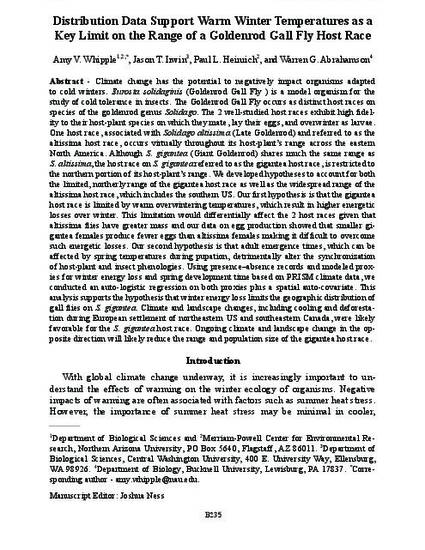
Article
Distribution data support warm winter temperatures as a key limit on the range of a goldenrod gall fly host race
Northeastern Naturalist
(2017)
Abstract
Climate change has the potential to negatively impact organisms adapted
to cold winters. Eurosta solidaginis (Goldenrod Gall Fly ) is a model organism for the
study of cold tolerance in insects. The Goldenrod Gall Fly occurs as distinct host races on
species of the goldenrod genus Solidago. The 2 well-studied host races exhibit high fidelity
to their host-plant species on which they mate, lay their eggs, and overwinter as larvae.
One host race, associated with Solidago altissima (Late Goldenrod) and referred to as the
altissima host race, occurs virtually throughout its host-plant’s range across the eastern
North America. Although S. gigantea (Giant Goldenrod) shares much the same range as
S. altissima, the host race on S. gigantea referred to as the gigantea host race, is restricted to
the northern portion of its host-plant’s range. We developed hypotheses to account for both
the limited, northerly range of the gigantea host race as well as the widespread range of the
altissima host race, which includes the southern US. Our first hypothesis is that the gigantea
host race is limited by warm overwintering temperatures, which result in higher energetic
losses over winter. This limitation would differentially affect the 2 host races given that
altissima flies have greater mass and our data on egg production showed that smaller gigantea
females produce fewer eggs than altissima females making it difficult to overcome
such energetic losses. Our second hypothesis is that adult emergence times, which can be
affected by spring temperatures during pupation, detrimentally alter the synchronization
of host-plant and insect phenologies. Using presence–absence records and modeled proxies
for winter energy loss and spring development time based on PRISM climate data, we
conducted an auto-logistic regression on both proxies plus a spatial auto-covariate. This
analysis supports the hypothesis that winter energy loss limits the geographic distribution of
gall flies on S. gigantea. Climate and landscape changes, including cooling and deforestation
during European settlement of northeastern US and southeastern Canada, were likely
favorable for the S. gigantea host race. Ongoing climate and landscape change in the opposite
direction will likely reduce the range and population size of the gigantea host race.
Keywords
- climate change,
- cold tolerance,
- entomology,
- host-race formation,
- speciation,
- Solidago,
- Eurosta,
- winter temperatures
Disciplines
Publication Date
Fall November, 2017
Citation Information
Amy V. Whipple, Jason T. Irwin, Paul L. Heinrich and Warren G. Abrahamson. "Distribution data support warm winter temperatures as a key limit on the range of a goldenrod gall fly host race" Northeastern Naturalist Vol. 24 Iss. Special Issue 7 Winter Ecology (2017) p. B235 - B250 Available at: http://works.bepress.com/warren_abrahamson/159/
